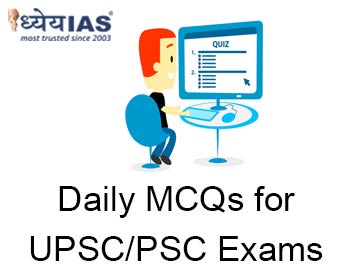Home > Daily-mcqs
Daily-mcqs 10 Oct 2025

Q1:
Consider the following statements about the regulatory framework governing drug manufacturing in India: 1. The primary legislation regulating drugs and cosmetics in India is the Drugs and Cosmetics Act, 1940. 2. The Central Drugs Standard Control Organisation (CDSCO) grant licensing of all drug manufacturers in India. 3. Good Manufacturing Practices (GMP) are mandatory standards laid down in Schedule M of the Drugs and Cosmetics Rules, 1945. 4. The Indian Pharmacopoeia (IP) defines the quality standards for drugs in India. Which of the above statements are correct?
A: 1 and 2 only
B: 1,3 and 4 only
C: 2 ,3 and 4 only
D: 1, 2, 3 and 4
Answer: B
Explanation:
Statement 1 is correct; the Drugs and Cosmetics Act, 1940 is the foundational law.
Statement 2 is incorrect; CDSCO regulates at the national level, but manufacturing licenses are primarily granted by state drug authorities, except for some critical drugs where CDSCO license is needed.
Statements 3 and 4 are correct; GMP standards are laid out in Schedule M, and Indian Pharmacopoeia sets drug quality standards.
Q2:
Why is India increasing engagement with the Taliban government in Afghanistan? 1. To recognize the Taliban government officially as the legitimate government of Afghanistan. 2. To preserve and protect its strategic influence and investments in Afghanistan. 3. To prevent Afghan territory from being used by terror groups targeting India. 4. To establish direct military presence in Afghanistan. Which of the above statements are correct?
A: 1 and 2 only
B: 1 and 3 only
C: 2 and 3 only
D: 1, 2, 3 and 4
Answer: C
Explanation:
India has not officially recognized the Taliban government yet, so statement 1 is incorrect.
India is engaging to protect its investments and strategic influence and to ensure Afghan soil is not used by terror groups, so statement 2 and 3 is correct.
There is no indication that India plans to establish a military presence in Afghanistan, so statement 4 is incorrect.
Q3:
What is Diethylene Glycol (DEG) primarily used for industrially?
A: As a pharmaceutical drug
B: As a flavoring agent
C: In antifreeze, brake fluids, and plastics
D: As a disinfectant
Answer: C
Explanation:
DEG is an industrial solvent commonly used in antifreeze, brake fluids, and plastic manufacturing, not as a drug or flavoring agent.
Q4:
1. e-NAM was launched in 2016 to unify agricultural markets across India. 2. The platform allows only government-run mandis to participate in trading. 3. e-NAM integrates quality testing, online payment, and logistics features. Which of the statements given above is/are correct?Consider the following statements about e-NAM:
A: 1 only
B: 1 and 3 only
C: 2 and 3 only
D: 1, 2, and 3
Answer: B
Explanation:
Statement 1 is correct — e-NAM was launched on 14 April 2016 to create a unified national agricultural market.
Statement 2 is incorrect — e-NAM links various APMC mandis as well as private markets and buyers.
Statement 3 is correct — e-NAM includes quality assaying labs, online payments, and logistics/warehousing features.
Q5:
Consider the following roles of the Central Drugs Standard Control Organisation (CDSCO): 1. Approving new drugs for the Indian market. 2. Granting manufacturing licenses for all pharmaceutical products. 3. Overseeing clinical trials and setting ethical guidelines. 4. Coordinating state drug control authorities. Which of the above roles are correctly attributed to CDSCO?
A: 1 and 2 only
B: 1,3 and 4 only
C: 2 ,3 and 4 only
D: 1, 2, 3 and 4
Answer: B
Explanation:
CDSCO approves new drugs, oversees clinical trials, and coordinates with state authorities.
However, CDSCO does not grant all manufacturing licenses; this is mainly the role of state drug control authorities.